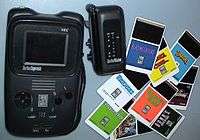TurboExpress
|
TurboExpress handheld | |
| Manufacturer | NEC Home Electronics |
|---|---|
| Type | Video game console |
| Generation | Fourth generation |
| Retail availability |
|
| Introductory price | $249.99 |
| Units sold | 1.5 million units |
| Media | HuCard |
| CPU | HuC6280 clocked at 7.16 MHz or 1.79MHz |
| Memory | 8KB RAM |
| Display | 400×270 pixels, 512 color palette, 481 colors on-screen |
| Power | 6 AA batteries or 6 volt AC adapter |
| Related articles | TurboGrafx-16 |
The PC Engine GT (Japanese: PCエンジンGT) is a handheld video game console by NEC Home Electronics, released in Japan in late 1990 and later in the United States as the TurboExpress. It is essentially a portable version of the TurboGrafx-16/PC Engine home console that came two to three years earlier. Its launch price in Japan was ¥44,800, whereas in the U.S. was $249.99, briefly raising to $299.99, soon dropping back to $249.99, and $199.99 by 1992.
The TurboExpress was technically advanced at the time, able to play all the TurboGrafx-16's HuCard games, and also featuring a TV tuner.[2] It has a 66 mm (2.6 in.) screen, the same size as the original Game Boy, and can display 64 sprites at once, 16 per scanline, in up to 481 colors from a palette of 512. It has 8 kilobytes of RAM. The Turbo runs its HuC6280 CPU at 1.79 or 7.16 MHz.
The TurboExpress primarily competed with Nintendo's Game Boy, Sega's Game Gear, and the Atari Lynx. However, with 1.5 million units sold, far behind its two main competitors, NEC failed to gain significant sales or market share in the handheld market.[3]
Hardware

Due to a problem with cheap capacitors, sound failure is a frequent problem with the TurboExpress, sometimes even in new systems.[4] The screen used in the TurboExpress was another source for problems, though it was state of the art when it was released. The LCD technology used was still fairly new and the rate of pixel failure was very high. Brand-new TurboExpress systems often had several bad pixels. Text is also difficult or impossible to read in certain circumstances, as many times fonts were written to be seen on a television screen, not on a small LCD screen. As a result, certain RPGs and adventure games can be difficult to play on the unit.
Some TurboGrafx-16 HuCards save game data to the internal memory of the TurboGrafx-CD unit, TurboDuo, or TurboBooster Plus (a peripheral for the core TG-16 console). The TurboExpress lacks this internal memory, and as a result it is not capable of saving in this manner. Most games provide a password save mechanism as an alternative.
The battery life is about three hours for 6 AA batteries. This is also a problem for other color and backlit or sidelit handhelds of the period, such as the Game Gear at 5–6 hours, the Sega Nomad at 2–3 hours, and the Atari Lynx at more than 4 hours.
Specifications
- CPU: HuC6280
- CPU speed: 7.16 MHz or 1.79 MHz (switchable in software)
- Resolution: 400x270
- Max colors: 512
- Max simultaneous colors: 481
- Max sprites: 64
TurboLink
The TurboLink allows two-player play. Falcon, a flight simulator, includes a "head-to-head" dogfight mode that can only be accessed via TurboLink, same as Bomberman 93 Com-Link multiplayer. However, very few TG-16 games offer co-op play modes especially designed with the TurboExpress in mind.
TurboVision

TurboVision is a TV tuner adapter for the TurboExpress. It allowed a player to either watch television, or go back to playing games with the flip of a switch; in other words, one may use the TurboExpress as a video monitor. It includes an RCA audio/video input for external composite video signals. However, due to the adoption of the High Definition Television HDTV digital standard, this adapter will no longer function as a television due to the lack of any HDTV digital processing circuitry (this tuner can only process an analog signal for television). Due to this limitation, the TV tuner adapter is now relegated to a collectible for most people although its RCA audio/video input function (albeit very limited with its low screen resolution) is still operational with the correct cables.
Reception
Computer Gaming World favorably compared TurboExpress to Game Boy, but stated that the NEC handheld "gobbles power like crazy ... almost forcing players to immediately purchase an AC adapter". The magazine nonetheless praised its compatibility with TurboGrafx games, and concluded that "to see this machine in action is to fall in love with it".[5]
Regardless of its technical advantages upon its release, the Turbo Express was not widely recognized or adopted by gamers.[6] In addition to NEC's marketing issues, the handheld was initially released for $299.99, significantly higher than popular competitors. Because of this price tag it was labeled as the "Rolls Royce of handheld systems".[7]
In popular culture
The TurboExpress appears in the movies 3 Ninjas and Enemy of the State, with the latter appearance taking place well after the system's demise. It also appears in the television series Doogie Howser, M.D.
See also
References
- ↑ http://www.pc-engine.co.uk/?section=systems
- ↑ http://www.defunctgames.com/history/21/the-turboexpress-has-won-the-war
- ↑ Snow, Blake (2007-07-30). "The 10 Worst-Selling Handhelds of All Time". GamePro. Archived from the original on 2007-10-12. Retrieved 2008-01-17.
- ↑ http://www.pcenginefx.com/forums/index.php?topic=702.0
- ↑ Adams, Roe R. III (January 1991). "Firing Up the TurboExpress / NEC's Hot New Hand-Held System". Computer Gaming World. p. 64. Retrieved 17 November 2013.
- ↑ http://www.allgame.com/cg/agg.dll?p=agg&sql=5:17673
- ↑ "Most Expensive Handheld Video Game System". The Most Expensive Journal. October 14, 2006.
- The Electronic Gaming Monthly 1991 Video Game Buyers Guide.
